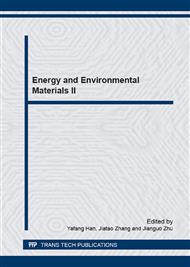[1]
J. Wang and C. Guo, Ultrafast dynamics of femtosecond laser-induced periodic surface pattern formation on metals. Applied Physics Letters, 87 (2005) 251914-251917.
DOI: 10.1063/1.2146067
Google Scholar
[2]
Tan Xinyu, Wei Huili, Mao Feng, Xu Huijin,Huang Xiangping, Yi Jia, Effect of Electronic Thermal Conductivity on Properties of Gold Target Material of Femtosecond Laser Ablation, Chinese journal of rare metals. 35(2011) 704-708.
Google Scholar
[3]
P. P. Pronko, S. K. Dutta, J. Squier, J.V. Rudd, D. Du, G. Mourou, Machining of sub-micron holes using a femtosecond laser at 800 nm, Optics communications, 114(1995) 106-110.
DOI: 10.1016/0030-4018(94)00585-i
Google Scholar
[4]
B. N. Chichkov, C. Momma, S. Nolte, F. Von Alvensleben, and A. Tnnermann, Femtosecond, picosecond and nanosecond laser ablation of solids. Applied Physics A. 63(1996) 109-115.
DOI: 10.1007/bf01567637
Google Scholar
[5]
G. Ausanio, A. C. Barone, V. Iannotti, L. Lanotte, S. Amoruso, R. Bruzzese, and M. Vitiello, Magnetic and morphological characteristics of nickel nanoparticles films produced by femtosecond laser ablation, Applied physics letters, 85(2004).
DOI: 10.1063/1.1815065
Google Scholar
[6]
Murnane M M, Kapteyn H C, Falcone R W, High-density plasmas produced by ultrafast laser pulses, Physical review letters. 62(1989) 155-158.
DOI: 10.1103/physrevlett.62.155
Google Scholar
[7]
Eliezer, N. Eliaz, E. Grossman, D. Fisher, I. Gouzman, Z. Henis, S. Pecker, Y. Horovitz, M. Fr aenkel, S. Maman and Y. Lereah, Synthesis of nanoparticles with femtosecond laser pulses, Physical Review B. 69(2004) 144119-144114.
DOI: 10.1103/physrevb.69.144119
Google Scholar
[8]
Marcus S, Lowder J E, Mooney D L, Large-spot thermal coupling of CO2 laser radiation to metallic surfaces, Journal of Applied Physics, 47(1976) 2966-2968.
DOI: 10.1063/1.323035
Google Scholar
[9]
J. A. McKay, R. D. Bleach, D. J. Nagel, J. T. Schriempf, R. B. Hall, C. R. Pond, and S. K. Manlief, Pulsed‐CO2‐laser interaction with aluminum in air: Thermal response and plasma characteristics, Journal of Applied Physics, 50(1979) 3231-3240.
DOI: 10.1063/1.326361
Google Scholar
[10]
Lin Z, Zhigilei L V, Temperature dependences of the electron–phonon coupling, electron heat capacity and thermal conductivity in Ni under femtosecond laser irradiation. Applied Surface Science. 253(2007) 6295-6300.
DOI: 10.1016/j.apsusc.2007.01.032
Google Scholar
[11]
Lin Z, Zhigilei L V, Celli V, Electron-phonon coupling and electron heat capacity of metals under conditions of strong electron-phonon nonequilibrium. Physical Review B. 77(2008) 075133-075150.
DOI: 10.1103/physrevb.77.075133
Google Scholar
[12]
Wang J, Guo C, Numerical study of ultrafast dynamics of femtosecond laser-induced periodic surface structure formation on noble metals. Journal of Applied Physics, 102(2007) 053522-053526.
DOI: 10.1063/1.2776004
Google Scholar
[13]
R. R. Fang, D. M. Zhang, H. Wei, D. Z. Hu, Z. H. Li, X. Y. Tan, M. Sun and F. X. Yang, A unified thermal model of thermo-physical effects with pulse width from nanosecond to femtosecond. European physical journal, Applied physics, 42(2008).
DOI: 10.1051/epjap:2008061
Google Scholar
[14]
Li Li, Zhang Duanming, Fang Ranran and Zu Xiaotao, Residual energy in femtosecond multipulse laser ablation of metal. 11 (2009)1671-1675.
Google Scholar
[15]
Hui Li Wei, Feng Mao, Xin Yu Tan, Xiang Ping Huang, Zhao Wang, Hui Jin Xu, Chang Yuan Zhang, Jia Yi, The influence of DOS effects on ablation properties in high energy femtosecond laser ablation process. Materials Science Forum. 689(2011) 11-15.
DOI: 10.4028/www.scientific.net/msf.689.11
Google Scholar


